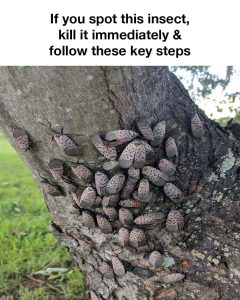
Check Your Backyard – You Could Be Hosting a Destructive Insect!
In recent years, a small yet incredibly destructive insect has been causing major concern across the United States. This pest, known as the spotted lanternfly (Lycorma delicatula), isn’t just another bug that ruins your outdoor activities—it poses serious threats to agriculture, the environment, and even the quality of life in many communities. Originally from Asia, this invasive species has quickly spread across several states, leaving significant damage in its path.
For homeowners, farmers, and environmentalists alike, the spread of the spotted lanternfly is more than just a nuisance. It’s a growing threat to crucial industries, ecosystems, and local economies. As this pest continues to spread across the U.S., it’s more important than ever to understand what it is, why it’s dangerous, and how to stop it.
The spotted lanternfly is deceivingly beautiful, with its brightly colored wings and seemingly harmless appearance. But don’t be fooled—this insect can cause serious damage. From vineyards to backyard gardens, the lanternfly has the potential to disrupt agricultural production on a massive scale. Beyond its economic impact, the lanternfly’s intense feeding habits can weaken or kill native trees and plants, leading to significant disruptions in local ecosystems and changing the landscape of affected areas.
What You Need to Know About the Spotted Lanternfly
What is the Spotted Lanternfly?
The spotted lanternfly is an invasive planthopper that originated in China, India, and Vietnam. It was first discovered in the U.S. in Pennsylvania in 2014 and has since spread to states like New Jersey, Virginia, and Ohio.
This insect primarily feeds on the sap of more than 70 plant species, including grapes, apples, pines, and maples, posing a serious threat to U.S. agriculture and forestry.
Adult lanternflies are about 1 inch long and half an inch wide, with distinctive wings. Their forewings are gray with black spots, and their hind wings feature striking red, black, and white patterns. As nymphs, they start off black with white spots and turn red before becoming adults.
Why is it Important to Control the Spotted Lanternfly?
The spotted lanternfly causes harm in several key ways:
Economic Impact: This pest is a significant threat to industries like viticulture (grape growing) and other agricultural sectors. The feeding habits of lanternflies stress plants, making them more vulnerable to disease and reducing crop yields.
Environmental Consequences: Beyond agriculture, lanternflies can damage or kill native trees, disrupting local ecosystems and altering the natural landscape.
Residential Nuisance: As they feed, lanternflies excrete a sticky substance called honeydew, which attracts bees and wasps and can lead to the growth of sooty mold. This mold can damage plants and leave patios, decks, and cars sticky and black.
Please Head On keep on Reading (>)
